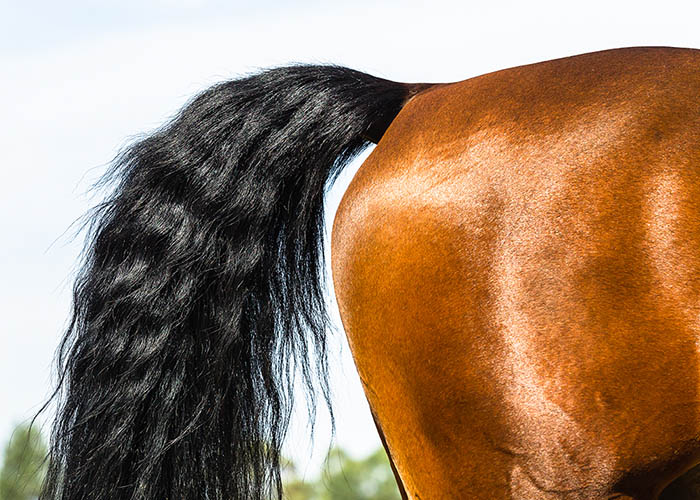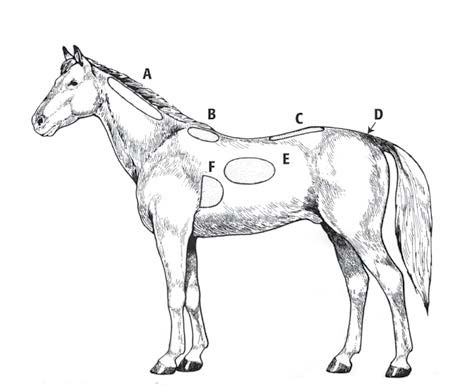
Nutrition plays a vital role in your horse’s health and overall wellness. In order to determine that your horse is getting the proper amount of calories in his or her diet, it is essential to be able to accurately assess their body condition. Every horse is an individual and carries their weight differently, making weighing your horse not as effective (and more challenging!) than other measures of their body.
The Henneke Body Score system is one of the most universally accepted ways to determine the condition of a horse. It rates the condition of the horse on an objective scale from one to nine, with one being emaciated and nine being extremely obese. In addition to being used by veterinarians and equestrians, it is also widely used by law enforcement agencies when screening for animal abuse. Continue reading to learn more about the Henneke Body Score system and what the various scores mean.
What is the Henneke Body Score System?
Don Henneke, PhD, developed the Henneke Body Score system, during his graduate studies at Texas A&M University. Originally a piece of his doctoral research regarding the correlation between body condition and a broodmare’s ability to conceive, it is now a standardized body condition system (BCS) within the equine industry. It looks at six locations on the horse’s body that quickly respond to weight gain or loss in the horse.
According to Texas A&M, “The Henneke Scoring system is a scientific method of evaluating a horse’s body condition regardless of breed, body type, sex, or age. Areas of the horse’s body that reflected changes in body fat content were selected, and a condition score system was developed. The system assigns a numerical value to fat deposition as it occurs in various places on the horse’s body. These specific locations that store fat are the lumbar spinous processes, ribs, tailhead, area behind the shoulder, neck, and withers.”
Determining A Horse’s Score
The ability to determine a horse’s BSC is an essential skill for every equestrian. It allows you to quickly assess your horse’s condition, while having a baseline understanding of their conditioning level.

The scoring process is hands-on, so it is necessary to have your horse secured on cross ties or held by someone else for the process. Then, using firm pressure, palpate your horse to determine the amount of fat and muscle in the following areas:
- A. Along the Neck
- B. Along the Withers
- C. The Crease in the Center of the Back
- D. The Tailhead
- E. The Ribs
- F. Along the Shoulder
Most equestrians work their way down the horse’s topline and then back through the midsection during this process. Using the chart below, assign each area a score ranging from one to nine. Your horse’s unique conformation may influence the ratings, but try to be as objective as possible.
| Neck | Withers | Back | Tailhead | Ribs | Shoulder | |
| 1 | Bony structures evident | Bony structures evident | Bony structures evident | No fatty tissues felt | Ribs are extremely prominent | The bony structure of the shoulder evident |
| 2 | No fatty tissues felt | Bony structures easily felt | Bony structures easily felt | Bony structures easily felt | Individual ribs are easily seen | Bony structures easily felt |
| 3 | Neck noticeably thin | Withers are easily identified | Fat beginning to build up along the back | Prominent tailhead | A small amount of fat over ribs, an outline of ribs discernable | Shoulder easily identified |
| 4 | Slight fatty tissues palpable, the neck may still appear thin | Withers not obviously thin or accentuated | Spine forms peak along the back | Prominent tailhead, some fat can be felt | A faint outline of ribs discernable | Shoulder not obviously thin |
| 5 | Neck blends with the body | Fat fills in withers so that is round over the spine | Back is level | Tailhead is not prominent, fat cover blends with the body | Ribs cannot be seen, but are easily felt | Shoulder blends into the body |
| 6 | Fat deposits beginning to build along the neck | Fat is beginning to be deposited along the withers | Fat beginning to build up along sides of the back | Fat over tailhead beginning to feel soft | Fat over ribs feels spongy | Fat deposits beginning to build behind the shoulder |
| 7 | Fat deposited along the neck | Full feeling fat deposits along withers | Crease developing (spine lower than the back fat) | Soft fat around tailhead | Difficult to feel individual ribs (beginning to fill with fat) | Fat deposited along the back of the shoulder |
| 8 | Noticeable thickening of neck | The area along withers filled with fat | Crease becoming more prominent | Very soft fat around tailhead | Difficult to feel ribs | Fat deposited along back of the shoulder, little to no definition |
| 9 | Bulging fat tissue | Bulging fat tissue | Bulging at and obvious crease down back | Bulging fat tissue | Bulging fat tissue, cannot palpate ribs | Bulging fat tissue |
After you have compiled the scores, put them into the following equation:
(Neck Score + Wither Score + Back Score + Tailhead Score + Rib Score + Shoulder Score)/6 = Henneke Body Condition Score
This is the finalized body that you can use to determine your horse’s overall condition.
What Do Scores Mean?
A score of one means that the horse is exceptionally emaciated and needs immediate veterinary attention that you can focus on weight gain. On the other hand, a score of nine indicates that your horse is extremely obese and needs an intervention in their diet. Veterinarians agree that most horses are healthy with a score ranging from four to seven, with a body score of five being considered ideal.
Typically, most horses, including performance horses and broodmares, should have a body score of five or six. This can fluctuate, however, based on your horse’s breed and use. For example, a fit racehorse may be healthy at a body score of a four, while a pulling draft horse may be appropriate at a seven. A veterinarian or equine professional can help you determine what score is most suitable for your horse.
Once you have a handle on the BCS system, you no longer need to refer to a horse as “skinny,” “thin,” “a bit overweight,” or “fat.” Instead, you can knowledgeably communicate with veterinarians and equine professionals regarding a horse’s body condition and overall wellness. Armed with this information, you can take a look at your horse’s feed program and exercise regime, making adjustments if necessary.
We can help too! If you have any questions regarding your horse’s diet after performing the Henneke Body Condition Scoring, please contact a member of our highly trained sales staff. We invite you to set up a complimentary equine nutrition consultation where we can help you build a feeding program that meets your horse’s nutritional and caloric needs.
